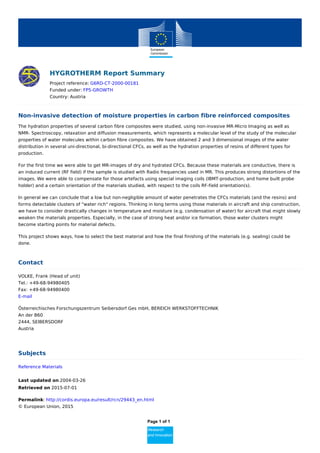CORDIS_report_29443_enHYGROTHERM
This document summarizes a research project that studied the hydration properties of carbon fiber composites using non-invasive imaging techniques. The techniques included MR-Micro Imaging, NMR spectroscopy, and relaxation and diffusion measurements. For the first time, the researchers were able to obtain 2D and 3D MR images of dry and hydrated carbon fiber composites. The imaging revealed that a low but detectable amount of water penetrates the composites and forms clusters within. Considering uses of these materials in aircraft and ship construction where temperature and moisture fluctuate, the water clusters could become starting points for material defects if strong heat or ice formation occurs. The project demonstrated ways to select the best materials and finishing techniques like sealing.

Recommended
More Related Content
Similar to CORDIS_report_29443_enHYGROTHERM
Similar to CORDIS_report_29443_enHYGROTHERM (20)
CORDIS_report_29443_enHYGROTHERM
- 1. HYGROTHERM Report Summary Project reference: G6RD-CT-2000-00181 Funded under: FP5-GROWTH Country: Austria Contact VOLKE, Frank (Head of unit) Tel.: +49-68-94980405 Fax: +49-68-94980400 E-mail Österreichisches Forschungszentrum Seibersdorf Ges mbH, BEREICH WERKSTOFFTECHNIK An der B60 2444, SEIBERSDORF Austria Subjects Reference Materials Last updated on 2004-03-26 Retrieved on 2015-07-01 Permalink: http://cordis.europa.eu/result/rcn/29443_en.html © European Union, 2015 Non-invasive detection of moisture properties in carbon fibre reinforced composites The hydration properties of several carbon fibre composites were studied, using non-invasive MR-Micro Imaging as well as NMR- Spectroscopy, relaxation and diffusion measurements, which represents a molecular level of the study of the molecular properties of water molecules within carbon fibre composites. We have obtained 2 and 3 dimensional images of the water distribution in several uni-directional, bi-directional CFCs, as well as the hydration properties of resins of different types for production. For the first time we were able to get MR-images of dry and hydrated CFCs. Because these materials are conductive, there is an induced current (RF field) if the sample is studied with Radio frequencies used in MR. This produces strong distortions of the images. We were able to compensate for those artefacts using special imaging coils (IBMT-production, and home built probe holder) and a certain orientation of the materials studied, with respect to the coils RF-field orientation(s). In general we can conclude that a low but non-negligible amount of water penetrates the CFCs materials (and the resins) and forms detectable clusters of "water rich" regions. Thinking in long terms using those materials in aircraft and ship construction, we have to consider drastically changes in temperature and moisture (e.g. condensation of water) for aircraft that might slowly weaken the materials properties. Especially, in the case of strong heat and/or ice formation, those water clusters might become starting points for material defects. This project shows ways, how to select the best material and how the final finishing of the materials (e.g. sealing) could be done. Page 1 of 1 Research and Innovation